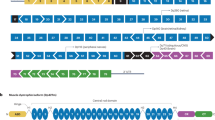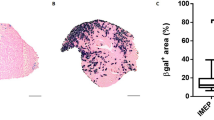Abstract
For the majority of Duchenne muscular dystrophy (DMD) mutations, antisense oligonucleotide (AON)-mediated exon skipping has the potential to restore a functional protein. Here we show that weekly intravenous injections of morpholino phosphorodiamidate (morpholino) AONs induce expression of functional levels of dystrophin in body-wide skeletal muscles of the dystrophic mdx mouse, with resulting improvement in muscle function. Although the level of dystrophin expression achieved varies considerably between muscles, antisense therapy may provide a realistic hope for the treatment of a majority of individuals with DMD.
This is a preview of subscription content, access via your institution
Access options
Subscribe to this journal
Receive 12 print issues and online access
$209.00 per year
only $17.42 per issue
Buy this article
- Purchase on Springer Link
- Instant access to full article PDF
Prices may be subject to local taxes which are calculated during checkout


Similar content being viewed by others
References
Hoffman, E.P., Brown, R.H. & Kunkel, L.M. Cell 51, 919–928 (1987).
Laing, N.G. In Molecular and Cell Biology of Muscular Dystrophy. (ed. Partridge, T.) 37–84 (Chapman & Hall, London, 1993).
England, S.B. et al. Nature 343, 180–182 (1990).
Gregorevic, P. et al. Nat. Med. 10, 828–834 (2004).
Mann, C.J. et al. Proc. Natl. Acad. Sci. USA 98, 42–47 (2001).
Dickson, G., Hill, V. & Graham, I.R. Neuromuscul. Disord. Suppl. 1, S67–S70 (2002).
Aartsma-Rus, A. et al. Neuromuscul Disord. Suppl. 1, S71–S77 (2002).
Lu, Q.L. et al. Nat. Med. 9, 1009–1014 (2003).
Lu, Q.L. et al. Proc. Natl. Acad. Sci. USA 102, 198–203 (2005).
Kurreck, J. Eur. J. Biochem. 270, 1628–1644 (2003).
Sazani, P. et al. Nat. Biotechnol. 20, 1228–1233 (2002).
Summerton, J. & Weller, D. Antisense Nucleic Acid Drug Dev. 7, 187–195 (1997).
Bruno, I.G., Wei, J. & Gilbert, C.J. Hum. Mol. Genet. 13, 2409–2420 (2004).
Gebski, B.L., Mann, C.J., Fletcher, S. & Wilton, S.D. Hum. Mol. Genet. 12, 1801–1811 (2003).
Goyenvalle, A. et al. Science 306, 1796–1799 (2004).
Acknowledgements
This work was supported by Parent Project, UK Muscular Dystrophy; aktion benni & co e. V., Germany; Medical Research Council UK and Limb Girdle Muscular Dystrophy Fund, Neuromuscular/ALS Center, Carolinas Medical Center, Charlotte, North Carolina, USA; Muscular Dystrophy Association, USA. Thanks also go to R.C. Woledge, Institute of Human Performance, University College London, UK; and A. Wilson, Structure and Motion Laboratory, Royal Veterinary College, London, UK, for providing equipment for part of the muscle contraction tests; R. Hemendinger, Neuromuscular/ALS Center, Carolinas Medical Center, Charlotte, North Carolina, USA, for critical reading and comments. T.P. is recipient of a Chaire Internationale de Recherche Blaise Pascal de l'Etat de la Region d'Ile de France, Fondation de l'Ecole Normale Superieure.
Author information
Authors and Affiliations
Corresponding author
Ethics declarations
Competing interests
The authors declare no competing financial interests.
Supplementary information
Supplementary Fig. 1
Illustration of exon 23 skipping with morpholinos in the mdx mouse. (PDF 124 kb)
Supplementary Fig. 2
Immunohistochemistry of dystrophin expression in tibialis anterior (TA) muscles 2 weeks after single intramuscular injection of the morpholinos. (PDF 4094 kb)
Supplementary Fig. 3
Systemic delivery of morpholino antisense oligonucleotide restores dystrophin expression bodywide to functional levels and improves dystrophic pathology. (PDF 1508 kb)
Supplementary Fig. 4
Significant reduction in percentage of centrally nucleated muscle fibers is observed in the muscles from mdx mice treated with morpholino AONs (seven intravenous injections, white bars) when compared to the muscles from control mdx (black bars). (PDF 208 kb)
Rights and permissions
About this article
Cite this article
Alter, J., Lou, F., Rabinowitz, A. et al. Systemic delivery of morpholino oligonucleotide restores dystrophin expression bodywide and improves dystrophic pathology. Nat Med 12, 175–177 (2006). https://doi.org/10.1038/nm1345
Received:
Accepted:
Published:
Issue Date:
DOI: https://doi.org/10.1038/nm1345
This article is cited by
-
Generalizable anchor aptamer strategy for loading nucleic acid therapeutics on exosomes
EMBO Molecular Medicine (2024)
-
Alternative splicing in prostate cancer progression and therapeutic resistance
Oncogene (2024)
-
Morpholino oligonucleotide-mediated exon skipping for DMD treatment: Past insights, present challenges and future perspectives
Journal of Biosciences (2023)
-
Extracellular polysaccharides purified (Polycan) from Aureobasidium pullulans SM‑2001 improves pathophysiology of dystrophin-deficient mdx mice
Molecular & Cellular Toxicology (2022)
-
Pharmacology and toxicology of eteplirsen and SRP-5051 for DMD exon 51 skipping: an update
Archives of Toxicology (2022)



